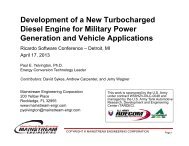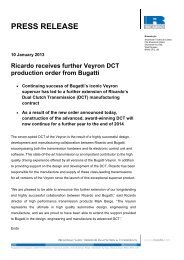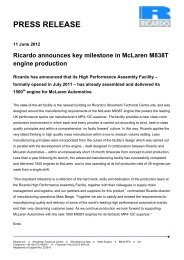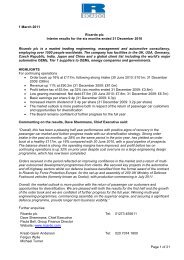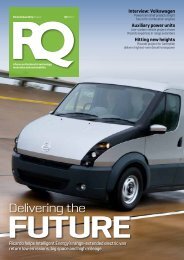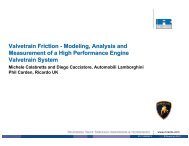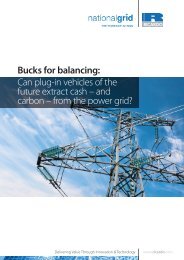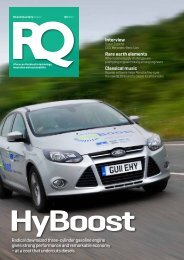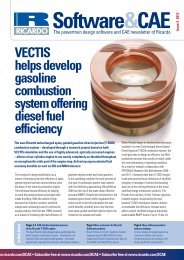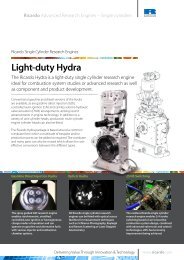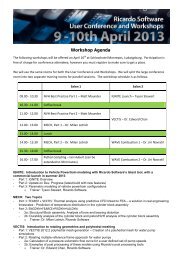Case Study - Ricardo
Case Study - Ricardo
Case Study - Ricardo
You also want an ePaper? Increase the reach of your titles
YUMPU automatically turns print PDFs into web optimized ePapers that Google loves.
ed engine, as well as development of<br />
the transient fuelling, spark timing and<br />
boost strategies. The key to success has<br />
been the systematic co-ordination of all<br />
these parameters during switching, a<br />
very challenging task.<br />
The prototype engine performed<br />
faultlessly in the subsequent<br />
development programme, validating<br />
both the switching strategies through<br />
demonstration of a wide range of<br />
constant torque and load transients,<br />
and also the performance of the<br />
aggressively downsized engine in both<br />
two- and four-stroke operation.<br />
Vehicle simulation based on<br />
engine tests<br />
Having validated the basic engine<br />
concept, the research team went on to<br />
assess the fuel economy improvement<br />
potential of the 2/4SIGHT engine<br />
through vehicle drive cycle and<br />
acceleration performance simulation.<br />
This work was based on the measured<br />
steady state fuel consumption and full<br />
load performance of the prototype<br />
2/4SIGHT engine and was carried<br />
out using the <strong>Ricardo</strong><br />
powertrain blockset in the<br />
MSC “EASY5” software<br />
package, which allows<br />
detailed modelling of<br />
engines, transmissions,<br />
drivelines, tyres and<br />
aerodynamics. The<br />
baseline vehicle<br />
for the study<br />
was an 1800 kg<br />
passenger car<br />
sold in the European<br />
market with a 3.5<br />
litre naturally aspirated V6 gasoline<br />
engine and five-speed conventional<br />
automatic transmission with torque<br />
converter. To verify the validity of the<br />
models and input data, the baseline<br />
vehicle fuel consumption results were<br />
compared with published data, which<br />
were reproduced by the model to an<br />
acceptable accuracy of 1 per cent.<br />
The simulation results indicate that<br />
vehicle acceleration performance,<br />
including launch from rest, can be<br />
maintained with a 2.1 litre V6 2/4SIGHT<br />
gasoline engine replacing the 3.5 litre<br />
baseline powerplant. This would deliver<br />
fuel savings of 27 per cent over the<br />
New European Drive Cycle (NEDC)<br />
and would reduce the vehicle CO2<br />
emissions of the baseline from 260<br />
grams per kilometre to 190 g/km.<br />
Dr Tim Lake, 2/4Sight chief engineer<br />
and veteran of the original Flagship<br />
studies, emphasises the full extent<br />
of the achievement that these results<br />
represent: “To put this into perspective,<br />
in two-stroke mode the test bed engine<br />
has achieved over 230 Nm per litre. This<br />
The 2/4SIGHT consortium<br />
<strong>Ricardo</strong>:<br />
Project leader and coordinator.<br />
Responsible within the project for the<br />
design, simulation and development of<br />
the prototype engine and integration<br />
of its systems. In parallel with the<br />
project <strong>Ricardo</strong> also designed the<br />
mechanical switching system to be<br />
used in the 2/4CAR vehicle project.<br />
DENSO:<br />
Responsible for development and<br />
supply of the direct fuel injection and<br />
advanced engine control systems.<br />
Ma 2T4:<br />
Contributed its knowledge and<br />
expertise of valvetrain switching<br />
technology.<br />
Brunel University:<br />
Carried out single-cylinder engine<br />
testing and development.<br />
The University of Brighton:<br />
Carried out multi-cylinder engine<br />
testing and combustion and cooling<br />
system analysis.<br />
The 2/4SIGHT project was partfunded<br />
by the UK Government<br />
through the Technology Strategy<br />
Board. The Board’s mission is to<br />
promote and support research into,<br />
and development and exploitation<br />
of, technology and innovation for<br />
the benefit of UK business, in order<br />
to increase economic growth and<br />
improve the quality of life.<br />
Q3, 2008 • RICARDO QUARTERLY REVIEW 13



